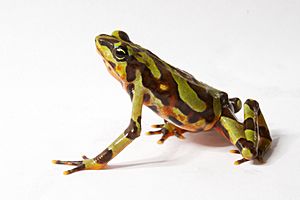Costa Rican variable harlequin toad facts for kids
Quick facts for kids Costa Rican variable harlequin toad |
|
|---|---|
 |
|
| Conservation status | |
| Scientific classification | |
| Synonyms | |
|
Synonymy
Atelopus bibronii Boulenger, 1894
Atelopus loomisi Taylor, 1955 Hylaemorphus bibronii Schmidt, 1857 Hylaemorphus dumerilii Schmidt, 1857 Hylaemorphus pluto Schmidt, 1858 Hylaemorphus plutonius Jan, 1857 Phrynidium bibronii (Schmidt, 1857) Phrynidium varium Lichtenstein & Martens, 1856 Phryniscus bibronii (Schmidt, 1857) Phryniscus dumerilii Brocchi, 1882 Phryniscus varius (Lichtenstein & Martens, 1856) |
The Costa Rican variable harlequin toad, also called the clown frog, is a small, colorful toad. Its scientific name is Atelopus varius. These toads are found in warm, tropical parts of the Americas.
Once, these toads lived all the way from Costa Rica to Panama. But now, they are in great danger. They are listed as critically endangered. This means they are very close to disappearing forever. Today, only a few groups of these toads are left. One small group was found in Costa Rica in 2003. Other tiny groups are in western Panama.
The main reasons for their decline are changes in weather, like temperature and rain. Also, a harmful fungus called Batrachochytrium dendrobatidis has spread. These problems are linked to global climate change. Another toad, A. zeteki, was once thought to be a type of A. varius. But now, scientists consider it a separate species.
Contents
Where the Harlequin Toad Lives
Historically, the Costa Rican variable harlequin toad lived in the Cordilleras de Tilaran mountains. This area is in Costa Rica and goes into western Panama. They lived on both the Pacific and Atlantic sides of these mountains.
These toads prefer places with hills and rocky streams. They can be found from lowlands up to high mountain areas. Their homes are usually between 6 and 2000 meters (about 20 to 6,500 feet) above sea level.
Harlequin Toad Habits and Home
The Costa Rican variable harlequin toad is active during the day. You can often spot it on rocks or in cracks near streams. It lives in humid forests, both in lowlands and mountains.
This toad mostly stays on land. It only goes into the water when it's time to breed. It relies on the mist from streams to stay moist.
These toads move slowly and often stay in one spot for a long time. Their bright, noticeable colors are a warning to other animals. This is called aposematic coloration. It tells predators that the toad is poisonous. The toad's skin contains a strong poison called tetrodotoxin. This poison can harm the nervous system.
The main food for these toads is small arthropods. These are tiny creatures like insects and spiders. They are most common during the dry season. The only known enemy of the harlequin toad is a type of fly. This fly lays its eggs on the toad's leg. The fly larvae then dig into the toad and eat it from the inside.
Saving the Harlequin Toad
In recent years, the Costa Rican variable harlequin toad has become very rare. Scientists first noticed its disappearance in the early 1990s. In one area of Costa Rica, the population dropped from 751 toads to zero. By 1996, people thought the toad was extinct in Costa Rica. However, in 2019, two small groups were found. In Panama, many toads died, and they were thought to be gone. But the species was also seen there again in 2019.
Scientists have several ideas about why these toads are disappearing. One idea is that rising temperatures in the tropics have caused problems. This warming trend happened in the late 1980s and early 1990s. It affected many lizards and amphibians, including other Atelopus species.
More recently, a harmful chytrid fungus has been linked to the decline of many amphibian species. This fungus is called Batrachochytrium dendrobatidis. It spreads through shed skin cells. The fungus infects the toad's skin, making it hard for the toad to breathe and control its body water. This can lead to death.
To help save the Costa Rican variable harlequin toad, people are working on a captive breeding program. This means raising the toads in special facilities to protect them. They are also working to protect the forests where these toads live. In March 2021, it was announced that the species was successfully bred in captivity outside of Panama for the first time.
See also
 In Spanish: Atelopus varius para niños
In Spanish: Atelopus varius para niños


